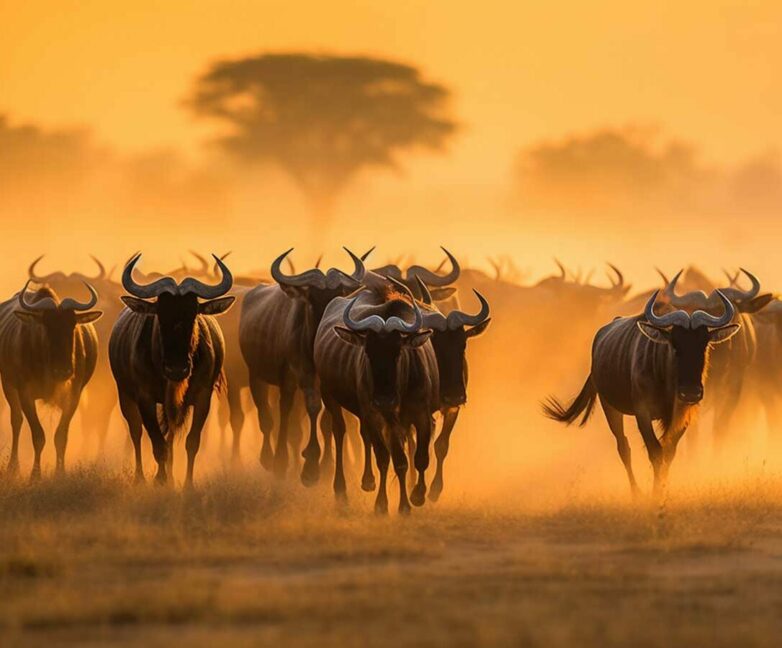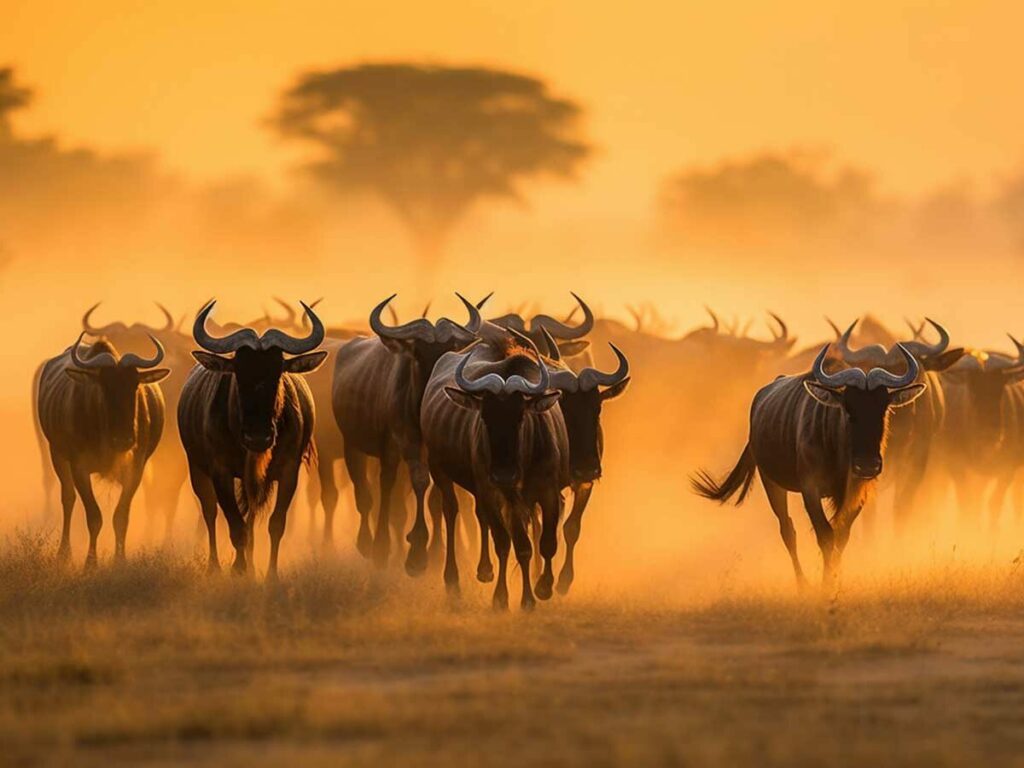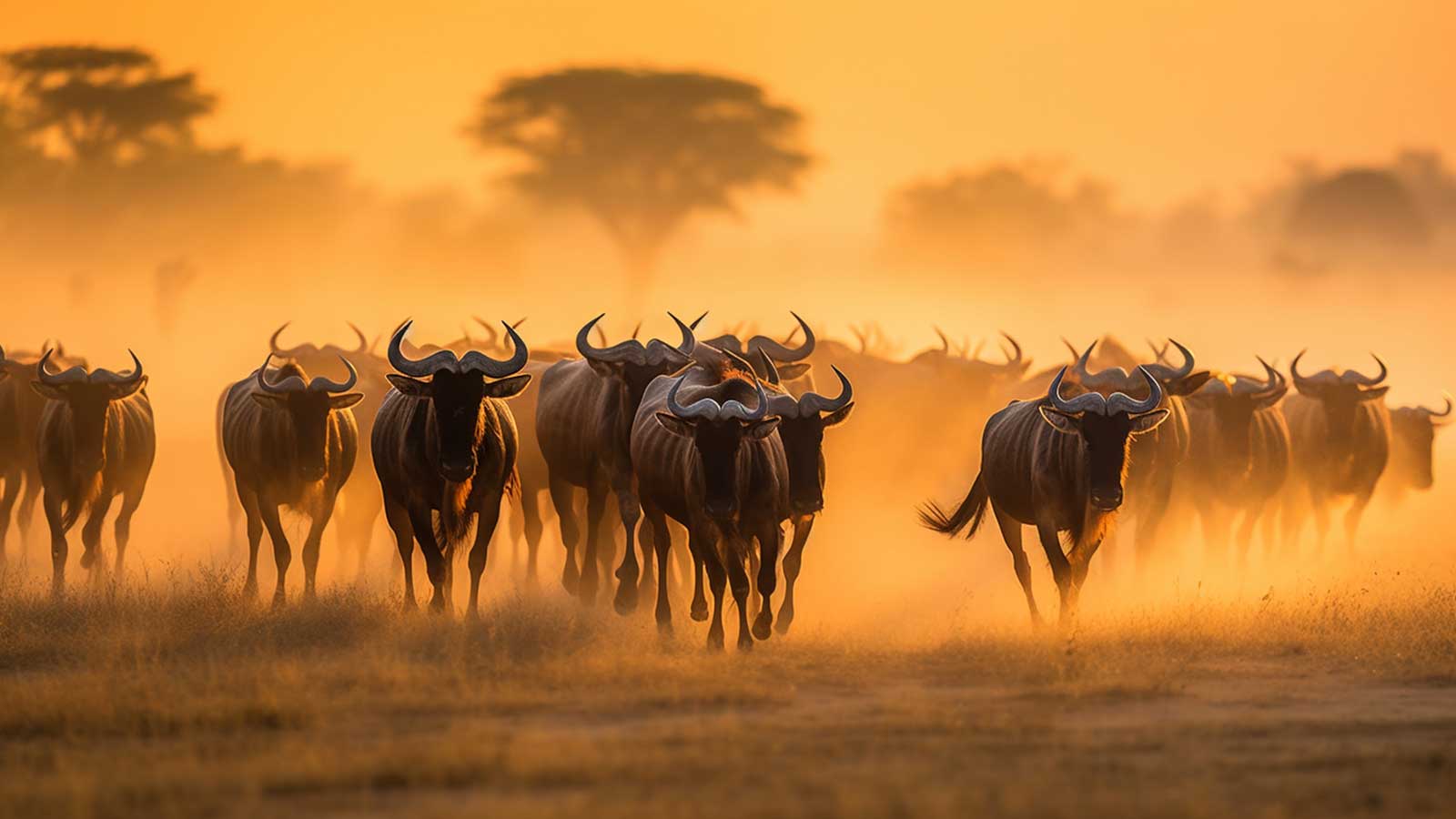


East Africa is home to some of the world’s most iconic and diverse wildlife experiences. From the thunder of migrating wildebeest across the Serengeti to intimate encounters with mountain gorillas in lush rainforest, the region offers year-round adventure for nature lovers and safari-goers alike.
Updated: Early November 2025
The great migration has now largely moved southwards into the northern and central Serengeti, with sizeable herds seen crossing the Mara River over the past two weeks and now spreading across the Seronera region and western corridor. Scattered groups still linger in the Mara Triangle and Mara North Conservancy in Kenya, but the bulk of the herds are grazing on the short, nutrient-rich grasses of the Serengeti following the first light rains. Predators—especially lion and hyena—are active around these moving herds, offering excellent game viewing opportunities.
The Mara remains lively with resident wildlife, including large prides of lion around Musiara and Topi Plains. Cheetah sightings are frequent near the Talek and Naboisho areas. Elephants are widespread, and leopards continue to be seen near the riverine forests. The grasses are beginning to recover after the migration, creating a beautiful green hue across the reserve.
Amboseli’s swamps are full, attracting large herds of elephant, particularly near Ol Tukai and Enkongo Narok. The backdrop of Mount Kilimanjaro is clear in the early mornings after recent showers. Lion and hyena sightings are common, and flamingos have been seen on the seasonal lake fringes.
Game viewing around Mzima Springs and Ngulia has been strong, with elephant, buffalo, and giraffe frequently sighted. Leopard have been reported near the Shetani lava flows, and birdlife is exceptional following light rains. The landscape remains lush in parts, making for beautiful photography.
Large herds of elephant are again moving through the open plains, often seen dust bathing in the red soil. Lion and cheetah sightings are consistent around Aruba Dam and Voi areas. With the vegetation regenerating after earlier dry spells, grazers such as zebra and oryx are widespread.
The Ewaso Nyiro River is flowing steadily, and the unique northern species—gerenuk, reticulated giraffe, Beisa oryx, and Grevy’s zebra—are all being seen regularly. Leopards have been active in the rocky outcrops, and the reserve is generally in excellent condition for wildlife viewing.
Private conservancies such as Ol Pejeta, Lewa, and Borana are offering outstanding sightings of black and white rhino, with healthy populations of lion, cheetah, and wild dog. Rains have freshened the landscape, and photography conditions are excellent.
The lake levels are stable, and the alkaline shallows are again supporting good numbers of flamingo alongside pelican and other waterbirds. Rhino sightings—both black and white—remain a highlight, and lion activity has been high in recent weeks.
The forested slopes are cool and misty, with regular sightings of buffalo, bushbuck, and the elusive bongo. Water levels at the waterfalls are high, and elephant are being seen at the forest clearings near The Ark and Treetops lodges.
The central and western Serengeti currently host the heart of the migration, with thousands of wildebeest and zebra covering the plains. Predators are highly active, particularly in the Seronera Valley. The landscape is turning green with early rains, making for spectacular scenes. Resident wildlife—lion, leopard, and elephant—remains abundant throughout the park.
Conditions in the crater are superb, with short grasses offering easy viewing of lion, black rhino, and large buffalo herds. Elephant bulls continue to frequent the Lerai Forest, while hyena and jackal are active around the open plains. Flamingos are gathering in increasing numbers on the crater lake.
Elephants are now dispersing after the dry season congregation, but game viewing remains strong around the Tarangire River. Giraffe, zebra, and eland are numerous, and the baobab-dotted scenery is at its finest after recent showers. Lions and leopards have been reported near Silale and Matete areas.
The park is lush and green, with good water levels and a rich concentration of birdlife, including pelicans, storks, and flamingos. Troops of baboon and blue monkey are active along the forest roads, and the famed tree-climbing lions have been spotted near the hippo pools.
Game concentrations remain high along the Ruaha River, with lion, leopard, and cheetah all frequently seen. Large herds of elephant and buffalo are present, and early rains have freshened the vegetation. Birdlife is outstanding as migrants return for the short rains season.
The Rufiji River is flowing well, with hippos and crocodiles abundant. Boat safaris offer excellent sightings, while open plains north of Lake Manze hold lion, wild dog, and giraffe. The park’s greenery is returning quickly with the first rains, improving both scenery and sightings.
Wildebeest, zebra, and giraffe are plentiful across the Mkata floodplain, and elephant herds are regularly observed. Lions have been seen along the main road near Mikumi Camp. Conditions are comfortable, with good light for photography.
Katavi remains one of Tanzania’s most dramatic wilderness areas. As rains begin, hippos are dispersing from the shrinking pools, while buffalo and lion dominate the plains. The park’s remoteness ensures an authentic safari experience.
Chimpanzee trekking is exceptional at present, with groups frequently located in the forested slopes behind the camps. The lakefront is calm and clear, offering ideal conditions for beach relaxation and boat excursions.
The short rains are arriving across much of East Africa, rejuvenating the landscapes and bringing cooler mornings and greener backdrops. Game viewing remains excellent across all major parks, with predators particularly active following the dry months. Migratory birds are returning, adding further colour and diversity to the bush experience.
